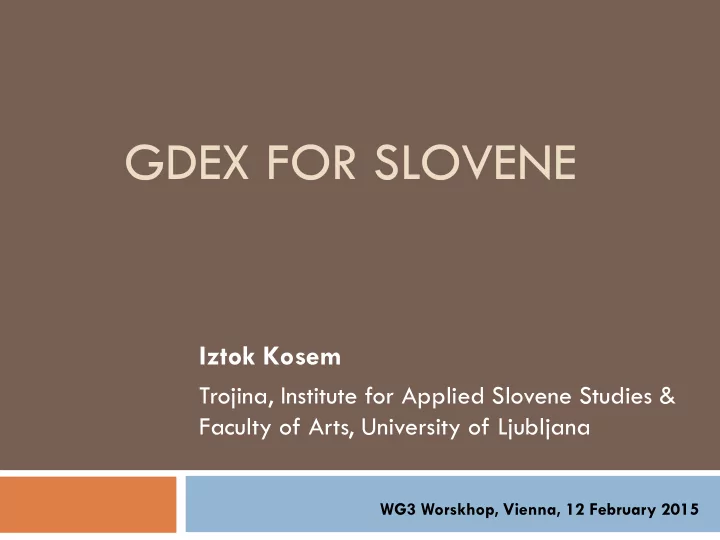

GDEX FOR SLOVENE Iztok Kosem Trojina, Institute for Applied Slovene Studies & Faculty of Arts, University of Ljubljana WG3 Worskhop, Vienna, 12 February 2015
GDEX for Slovene Communication in Slovene project 2008-2013 3,2 million euro http://www.slovenscina.eu Slovene Lexical Database (Krek & Gantar 2012) Corpora: 620-million word FidaPLUS corpus (v1) 1.2-billion word corpus of Slovene (Gigafida) (v2) Vienna, 12 February 2015
Vienna, 12 February 2015
Vienna, 12 February 2015
GDEX for Slovene v1 GDEX for Slovene (Kosem, Husák and McCarthy, 2011) Initial GDEX configuration: Non-language specific classifiers of English GDEX analysis of manually selected examples in the database (using WEKA tool) Evaluation in TBL: Comparing different GDEX configurations Logging good (selected) and “bad” (unselected) examples Improving GDEX for Slovene based on: Recorded observations Analysis of good (and bad) examples Result: GDEX configuration Slovene3b
GDEX for Slovene – version 1 Manually selected Slovene1(b) examples from evaluation the database + WEKA WEKA analysis Slovene2 evaluation Slovene1 vs + WEKA Slovene2 Slovene3 evaluation Slovene1 vs + WEKA Slovene3 Slovene3b GDEX evaluation Slovene3 vs + WEKA for Slovene Slovene3b
Findings Sentence length from 8-30 to 15-35 considerable improvement Keyword position English – beginning of the sentence (0-20%) Slovene – middle to end of the sentence (40-100%) Penalizing repetitions of the word in the same example Sentence length (max 60) Word length (>18 characters) Vienna, 12 February 2015
GDEX for Slovene – from v1 to v2 Automatic extraction: point of departure GDEX for Slovene v1 Aim: separate GDEX configurations for nouns, verbs, adjectives, adverbs Different task: first 3 examples of each collocate need to be good (not any 3 out of 10 examples)
GDEX for Slovene – from v1 to v2 Automatic extraction: point of departure GDEX for Slovene v1 Aim: separate GDEX configurations for nouns, verbs, adjectives, adverbs Different task: first 3 examples of each collocate need to be good (not any 3 out of 10 examples)
GDEX (API) corpus corpus database GDEX (via TBL) + example selection Example selection database Vienna, 12 February 2015
Classifiers – no change Boolean classifier group (binary) (weight = 100) Whole sentence Classifier matching regexp ([<|\][>/\\]) Any token frequency < 3 “Penalty” classifiers Proper nouns (weight = 2): -0.2 deduction for each proper noun Example diversity: Levenshtein distance > 30%
Fine-tuning of classifiers Removed classifiers: Boolean: maximum token length Percentage of tokens with frequency above 104 Classifiers moved under boolean: classifier penalizing web addresses, emails keyword repetition (matching lemma, not token) Changed classifiers: Token length (originally 6 – from English GDEX 8) maximum sentence length = 60 35-40 tokens Changed weights: Sentence length (2 10) Capital letters (2 4) Symbols (1 5) Punctuation (1 5)
New classifiers Blacklist of sentence-initial words: sledi, zatorej, torej, nato, vendar , gre, oboji, dotlej, zato, tovrsten, to, ta, slednji, tak, takšen, potekati both, it follows, thus, therefore, then, but, this is, till then, because, this type of, this, that, latter , it takes place Blacklist of sentence-initial phrases Penalty for lemmas with frequency below 600 or 1000 Separate classifier for commas (penalty for multi- clause sentences) Third-collocate classifier! (e.g. take a long walk )
Summary Slovenian experience: Good results Particularly good at helping to identify good database examples More useful when used at collocational (under gramrels) than at lemma level GDEX already used in various projects Lexicographic (Slovene lexical database) Terminological (TERMIS) Pedagogical (Pedagogic corpus-based grammar) Vienna, 12 February 2015
Recommend
More recommend